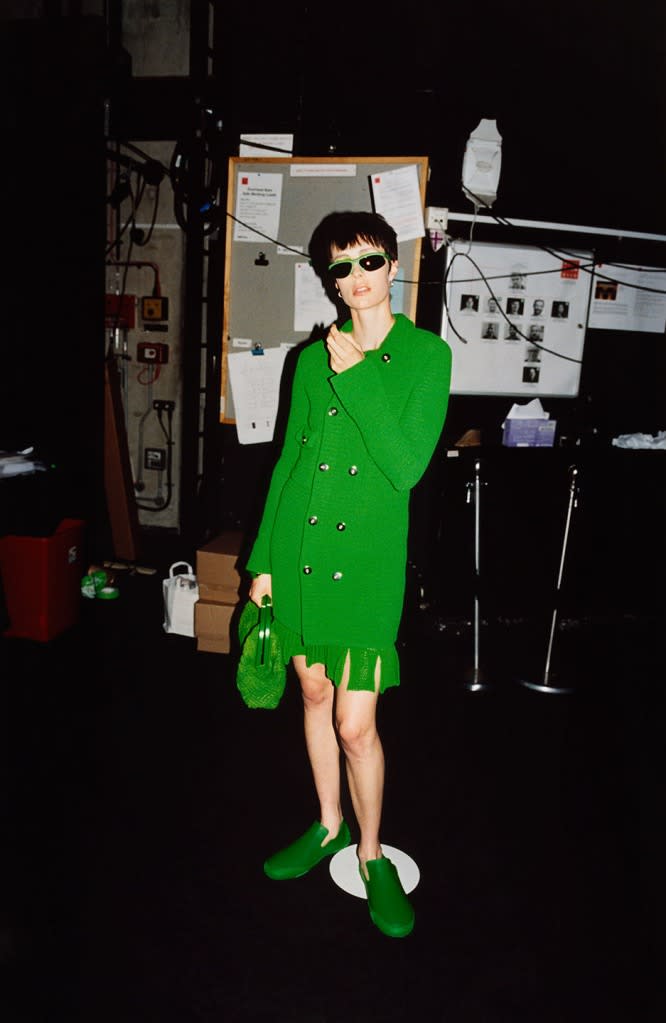Year in Review: Bottega Veneta, Daniel Lee Surprise Split
- Oops!Something went wrong.Please try again later.

Eyes will be on the new course of Bottega Veneta when Matthieu Blazy holds his first show as creative director on Feb. 26. The event will also mark the brand’s return to Milan Fashion Week after shows held in cities such as London, Berlin and Detroit over the past few seasons.
Blazy, previously design director, was promoted internally a few days after the surprising and sudden exit of Daniel Lee in November. The breaking news made headlines for days to come, with many wondering what had prompted the split, since Lee had helped revive the heritage brand, turning it into a hot selling ticket and a trend-setting, influential label, injecting a new and youthful spirit to the collections.
More from WWD
Given the success and level of attention the creative director brought to the brand in a little more than three years, it seemed a counterintuitive move.
Precisely because of this upward trajectory, the industry was left wondering what could have triggered Lee’s abrupt departure. Many speculated that parent company Kering’s decision was overdue and had to be taken despite the successful streak. It seemed obvious from the start that the decision was not motivated by financial issues.
Rumors about Lee’s personality had been circulating for some time in the industry, but designers have often been cut some slack in the name of creativity. And Lee certainly delivered in terms of creativity, as his designs, especially the accessories — from the signature Pouch bag, which was introduced in his first collection in 2019, or the Cassette bag and the Lido sandals — all flew off the shelves.
Apparently this was not enough for Kering or Bottega Veneta’s chief executive officer Leo Rongone, who was, according to sources, losing key figures within the company, starting from prized and highly skilled veteran artisans at the company’s headquarters in Vicenza to pivotal managers who clashed with Lee, who was often described as “uncommunicative.” He was also known to work on his own schedule — often at night — which made personal relations, key in such creative positions, more difficult.
Sources also believed the organization of Bottega Veneta’s show in Detroit in October took a toll, creating more stress and drama than expected — or than was seen as necessary. One source contended that Lee was “fired with immediate effect” because of the tension created in Detroit and some of his behavior there.
While sources claimed that Lee was shown the door, in a joint statement the exit was defined by Bottega Veneta and the designer as a joint decision. Rongone admitted that the designer “provided Bottega Veneta with a fresh perspective and a new sense of modernity, while remaining respectful of the brand’s 50-year heritage,” which helped grow the label. But he did not elaborate on the reasons for Lee’s departure, which contributed to raising more questions about the split.
Lee joined Bottega Veneta at age 35 on July 1, 2018. A graduate of Central Saint Martins, he was previously director of ready-to-wear at Celine, owned by rival conglomerate LVMH Moët Hennessy Louis Vuitton. This followed earlier stints at Maison Margiela, Balenciaga and Donna Karan. Lee succeeded Tomas Maier, who helped shape and and elevate Bottega Veneta for 17 years.

Courtesy of Bottega Veneta
Blazy, who joined the Italian brand last year, is expected to build on his predecessor’s new and strong take on the label, as he is said to share a similar aesthetic with Lee.
Born in Paris in 1984, Blazy is a graduate of La Cambre in Brussels, and he started his fashion career as men’s designer for Raf Simons.
Blazy spent two years and seven months at Calvin Klein working on men’s and women’s collections and was part of the inner circle that Simons brought with him to New York. That circle also included Pieter Mulier, Simons’ longtime number two who held the title of creative director at Calvin Klein and joined Simons for runway bows. Before Calvin Klein, Blazy worked in the studio of Celine under then-creative director Phoebe Philo, and for four years at Maison Margiela, ultimately responsible for its couture line, dubbed Artisanal.
In recent seasons, Lee has built momentum for the brand with disruptive strategies like erasing its Instagram account and staging traveling fashion shows in locations including London and Berlin. On the latter occasion in early April, the company was at the receiving end of some harsh social media backlash after staging Salon 2 to parade the fall 2021 collection at the city’s Berghain techno club. The show attracted guests such as U.K. rappers Skepta and Slowthai, DJ Honey Dijon, Nigerian singer Burna Boy, ballet dancer Roberto Bolle and designer Stefano Pilati. But the event was seen as an untimely decision as the German city was still in lockdown and grappling with surging COVID-19 cases.
“Social media represents the homogenization of culture,” Lee said in March. “I feel that everyone constantly sees the same stream of information. As a creative, I find that very limiting,” Lee added as the brand revealed the release of Issue 01, a new visually focused, quarterly digital journal aimed at exploring an alternative way to engage with its collaborators and worldwide audience. It remains to be seen if Blazy will stay true to Lee’s communication strategy.
In 2020, Bottega Veneta was the only Kering brand for which breakout figures are disclosed to post growth, with sales up 4.8 percent in comparable terms despite the impact of the coronavirus pandemic. In the third quarter of 2021, organic revenues at the house rose 8.9 percent year-over-year.
“Bottega Veneta continues to do a great job attracting new clients, with sales to younger generations growing faster than the average. At the same time, it is strengthening its appeal with existing customers, resulting in a very well-balanced client mix,” Jean-Marc Duplaix, chief financial officer of Kering, said at the time. “Bottega Veneta is demonstrating quarter after quarter the success of our strategy as it expands the house’s territory, tightens its exclusivity and turns into a truly global luxury brand.”
Last year, the brand represented 9 percent of Kering’s sales. Leather goods accounted for 74 percent of the total revenues at Bottega, followed by shoes with 16 percent and ready-to-wear representing only 7 percent.
Sign up for WWD's Newsletter. For the latest news, follow us on Twitter, Facebook, and Instagram.

